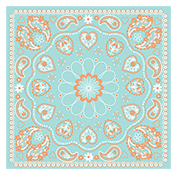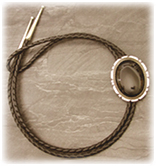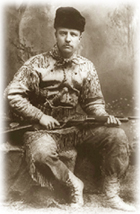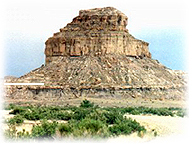|
|||
 Banco BancoA bench made of plaster, traditionally built out from the wall of an adobe home. (~Aimee) Bandana Definition: “a large handkerchief or neckerchief, typically of cotton, often having a colorful pattern; a red paisley bandana kerchief, neckerchief, headscarf, or babushka.” A kerchief (from the French, couvre-chef, “cover the head”) is a square or triangular piece of cloth tied around the head or neck for protective or decorative purposes. Bandannas are worn as a practical garment by outdoor workers such as farmers and cowboys, who wear them around the neck to wipe the sweat off their faces and keep dust out of their collars.  There are several methods of bandana folding and many different uses for them. In the past, these handy handkerchiefs were folded into common workers’ squares, and tucked into pockets for the more traditional uses, but they have also been used as bandages, compresses to stop bleeding, and folded into triangles, to be worn around the neck as slings. Cotton bandanas in regulation sizes, are available in a multitude of patterns and colors. Today, bandanas have many new uses, and are in style as head coverings, and are folded and worn in different ways. Bandana folding: Regular bandanas, being square, are folded into a triangle, placed low on the forehead, just above the eyebrows, and tied in a manner to secure the back triangle to the head. These are often worn by motorcycle enthusiasts underneath their helmets, or as Western wear, alone or under a cowboy hat. Folded bandanas can also become a type of head scarf, when they are folded into a triangle, placed on the top of the head, brought behind the ears, and tied to leave the back triangle point free.  A Bit of Personal Bandana Trivia: About 10 years ago, I took to wearing a bandana on my head almost every time I went outside or into town (the exception would be if I chose to wear a cowboy hat, instead). For quite awhile I was unaware that anyone took notice of it. Then, one day I met with a woman for some business concerns and the first thing she said to me was, “Oh, you’re the woman who always wears the bandana! I see you at the market quite often.” Now, I find more and more, people seem to compliment me on the bandana I am wearing. I have collected quite a few unusual and colorful ones over the years! (~Jean) A Bit of Personal Bandana Trivia: About 10 years ago, I took to wearing a bandana on my head almost every time I went outside or into town (the exception would be if I chose to wear a cowboy hat, instead). For quite awhile I was unaware that anyone took notice of it. Then, one day I met with a woman for some business concerns and the first thing she said to me was, “Oh, you’re the woman who always wears the bandana! I see you at the market quite often.” Now, I find more and more, people seem to compliment me on the bandana I am wearing. I have collected quite a few unusual and colorful ones over the years! (~Jean)Beans (see Frijoles) An edible seed produced in pods of vines and bushy plants of the legume family. A staple of many cultures, including the Spanish, Mexican and American Indian, beans are an excellent source of amino acids, (protein) B vitamins and iron. (~Aimee)  Blue Corn Blue CornA staple of the Pueblo Indians, blue corn is high in protein and lysine. Meal made from blue corn is courser, with a nuttier and sweeter taste than yellow corn meal. Blue corn is also an important element in some Native American religious rituals. It was used to strengthen pregnant and lactating women, and before strenuous activities or preparing for journeys. (~Aimee) Blue Jeans (or Denim) Denim originated independently in France and India, and was traditionally dyed with natural indigo dye. Trousers made from the material were produced in a town near Turin, Italy, and were popularized in the 16th century. Pants made of this material were originally worn by sailors, who required durability in their uniforms. The jeans would be dragged behind ships in fishing nets to wash them, where exposure to salt water and the sun would eventually bleach them white. In the 1850s, a dry goods merchant named Levi Strauss sold blue jeans under the Levi name in the mining towns of Northern California. A local tailor, who frequently made repairs to miners' jeans, had the idea to reinforce the pocket corners and waistband of the jeans with copper rivets. He approached Strauss with the idea of going into business together, and the modern blue jean was born. Popular with the Cowboy and all western-style enthusiasts, Levi (and other later brand name) blue jeans are almost synonymous with the American Southwest and its easy-going lifestyle. (~Aimee) Blumenschein, Ernest One of the founding members of the Taos Society of Artists, or the "Taos Founders," as they are called, New York Artists Ernest Blumenschein and Bert Geer Phillips were on a fateful sketching trip to Mexico in 1898, when their wagon broke a wheel. According to legend, "Blumy" as he was called, left the wagon and hiked into town to arrange for the repair. By the time the wagon was ready, Phillips and Blumenschein were so taken with the landscape and local culture, they decided to stay in Taos to paint rather than continuing on to Mexico. Several months later, Blumenschein would return to New York without his friend, who had since fallen in love with the local doctor's sister, and decided to stay. Blumenschein would return nearly every summer until 1919, when he and his family made Taos their permanent home. The Blumenschein home is now a museum which is maintained much as it was when the artist and his family lived in Taos. (~Aimee) NOTE: Read more about the Taos Society of Artists in our feature on Taos as an Art Colony.  Bolo Tie Bolo TieA western-style tie consisting of a cord or braided leather, finished in aglets and secured with an ornamental slide. Bolo slides and tips in silver have been part of pueblo silversmithing traditions since the mid-20th century. In 1987, a non-binding measure was passed to designate the bolo as the official neckwear of New Mexico. (~Aimee)  A Bit of Bolo Tie Movie Trivia: In the classic 1980s teen flick, “Pretty In Pink,” the hip punk character, “Duckie” (played by Jon Cryer), wears a fabulous bolo tie to accent his eclectic, formal prom attire. And what a performance he gave in this film! His lip-synched rendition of Otis Redding's Try a Little Tenderness is a real show stopper. But I digress: Bolo ties have always been popular with rock stars and other counterculture types, and women have enjoyed making a fashion statement with them, as well. (~Jean) A Bit of Bolo Tie Movie Trivia: In the classic 1980s teen flick, “Pretty In Pink,” the hip punk character, “Duckie” (played by Jon Cryer), wears a fabulous bolo tie to accent his eclectic, formal prom attire. And what a performance he gave in this film! His lip-synched rendition of Otis Redding's Try a Little Tenderness is a real show stopper. But I digress: Bolo ties have always been popular with rock stars and other counterculture types, and women have enjoyed making a fashion statement with them, as well. (~Jean)Boy Howdy  Definition: “an exclamation of enthusiastic agreement which can be used in both a genuine or sarcastic tone; similar in usage to ‘wow,’ ‘oh, man,’ or ‘yep’; can be used to add emphasis to a statement; Southern slang; an interjection; often used as an expression of surprise for large quantities of something, or the severity of something.” This is a Western-style phrase that I use quite often when talking to my dogs, especially if it is in regard to something about which they are really excited. (~Jean) Definition: “an exclamation of enthusiastic agreement which can be used in both a genuine or sarcastic tone; similar in usage to ‘wow,’ ‘oh, man,’ or ‘yep’; can be used to add emphasis to a statement; Southern slang; an interjection; often used as an expression of surprise for large quantities of something, or the severity of something.” This is a Western-style phrase that I use quite often when talking to my dogs, especially if it is in regard to something about which they are really excited. (~Jean)Buckskin (or Buckskins) Clothing made from the soft leather of deer or elk, with the underside (or the suede side) turned to the outside. Usually consisting of a jacket and leggings, buckskins were usually trimmed along the seams with fringe, to wick the water away in the rain. Originally common to certain tribes of American Indians, buckskins became popular among mountain men for their warmth and durability. Some of the famous icons of the Old West who wore buckskins were Wild Bill Hickock, Calamity Jane, Buffalo Bill, and Annie Oakley. (~Aimee) Buckskin (Horse) Buckskin also refers to a quite beautiful color of horses, with a body of silver-grey or yellow-grey, sometimes known as dun. Their mane and tail are often black, but can also be similar to the body color. (~Aimee) Burrito  Definition: “a Mexican dish consisting of a tortilla rolled around a filling, typically of beans or ground or shredded beef.” Origin: Latin American Spanish, diminutive of burro; ‘little burro.’ ” A burrito consists of a flour tortilla wrapped or folded around a filling. The flour tortilla is usually lightly grilled or steamed to soften it and make it more pliable. In America, fillings usually include a combination of ingredients such as meat, Spanish rice, pinto or refried beans, cheese, shredded lettuce, salsa, guacamole, and sour cream. The size of a burrito can vary greatly, with some quite large, or jumbo size. And in some restaurants, a whopping burrito is served on a plate, topped in green chili sauce. In the Southwest, pretty much anything can, and will, end up in a made-to-order burrito. Breakfast burritos are also quite popular, and they usually consist of potatoes and scrambled eggs, but sometimes bacon, beans, rice, onions, and guacamole may be added. Fast food giant, McDonald's, introduced their version of the breakfast burrito in the late 1980s and by the 1990s, more fast food chains jumped on the bandwagon, with Taco Bell, Sonic, and Carl's Jr. offering this morning treat (smaller in size) on their menus. The burrito is surely one of the most requested and well-loved Mexican dishes of all time. (~Jean) Definition: “a Mexican dish consisting of a tortilla rolled around a filling, typically of beans or ground or shredded beef.” Origin: Latin American Spanish, diminutive of burro; ‘little burro.’ ” A burrito consists of a flour tortilla wrapped or folded around a filling. The flour tortilla is usually lightly grilled or steamed to soften it and make it more pliable. In America, fillings usually include a combination of ingredients such as meat, Spanish rice, pinto or refried beans, cheese, shredded lettuce, salsa, guacamole, and sour cream. The size of a burrito can vary greatly, with some quite large, or jumbo size. And in some restaurants, a whopping burrito is served on a plate, topped in green chili sauce. In the Southwest, pretty much anything can, and will, end up in a made-to-order burrito. Breakfast burritos are also quite popular, and they usually consist of potatoes and scrambled eggs, but sometimes bacon, beans, rice, onions, and guacamole may be added. Fast food giant, McDonald's, introduced their version of the breakfast burrito in the late 1980s and by the 1990s, more fast food chains jumped on the bandwagon, with Taco Bell, Sonic, and Carl's Jr. offering this morning treat (smaller in size) on their menus. The burrito is surely one of the most requested and well-loved Mexican dishes of all time. (~Jean) A Bit of Personal Burrito Trivia: Some years ago, while in San Francisco, I first had the extraordinarily flavored Mexican style pork often found in burritos, or served with rice and beans. When I returned to New Mexico, I tried to find out what this amazing flavor was, at first to no avail...until I had my first pork burrito in Taos. That was it! The flavor is so rich, like roasted pork, only better. It can't be duplicated. Of course now I know this is “carnitas,” sometimes referred to as “pulled pork.” I love to bring home a wonderfully flavorful pork burrito (with beans, a few potatoes, and avocado) from my favorite Taos establishment, add a little of my cherished chipotle sauce, then with a few chips and an iced tea, have a feast! (~Aimee) A Bit of Personal Burrito Trivia: Some years ago, while in San Francisco, I first had the extraordinarily flavored Mexican style pork often found in burritos, or served with rice and beans. When I returned to New Mexico, I tried to find out what this amazing flavor was, at first to no avail...until I had my first pork burrito in Taos. That was it! The flavor is so rich, like roasted pork, only better. It can't be duplicated. Of course now I know this is “carnitas,” sometimes referred to as “pulled pork.” I love to bring home a wonderfully flavorful pork burrito (with beans, a few potatoes, and avocado) from my favorite Taos establishment, add a little of my cherished chipotle sauce, then with a few chips and an iced tea, have a feast! (~Aimee)Burro (or Donkey) A domesticated member of the horse family, the donkey's wild ancestor is the African Wild Ass. Males are called jacks and females jennies. Offspring have the same names as horses (i.e., foal for either sex under one year, and colt and filly for males and females who are over one year old). Different species within the Equidae, or horse family can interbreed, however, their offspring are almost always sterile. A mule is the offspring of a jack, or male donkey, and a mare, or female horse. Though rarely successful, the offspring of a stallion (male horse) and a jenny (female donkey) is a hinny. The Spanish brought burros to North America where they quickly became the chosen beast of burden of early prospectors, due to their sure-footedness. While many use the terms donkey and burro interchangeably, others call the smaller Mexican descendants burros, and their larger cousins, imported directly from Europe, donkeys. Burros which were abandoned or ran away gave rise to feral burros in the Western range lands. Fortunately, these animals are now protected in New Mexico, where they are considered to be a living legacy. During drought conditions, herds are at risk, and are routinely thinned to preserve grazing. Roundups remove a percentage of the feral burros which are then auctioned to the public. Wild burros are clever and curious, making excellent pets when treated well and trained properly. Once trust has been established, they greatly enjoy the company of humans. (~Aimee)  NOTE: See our special feature on the Burro in Plants & Wildlife. NOTE: See our special feature on the Burro in Plants & Wildlife.Butte An isolated hill with steep sides and a flat top, similar to but narrower than a mesa. The typical isolation of buttes makes for many named "Lone Butte" in the Western United States, including at least two in New Mexico alone. (~Aimee) Pictured top to bottom: 1} Banco seating in an abobe style house; 2} A fashionable bandana; 3} Basket of blue corn; 4} Bolo tie with oynx cabochon; 5} Teddy Roosevelt in buckskins; 6} A popular Mexican dish, the burrito; 7} Fajada Butte in Northern New Mexico's Chaco Canyon |
|||
Home | Food | Lodging | Merchants | Services | Real Estate | Art & Galleries | Entertainment | Recreation Ski Areas | Mind-Body-Spirit | Taos Information | Local Color | Taos Pueblo | High Road to Taos | Taos Plaza | Ranchos de Taos Scenic Beauty | Day Trips | Chili | Special Events | Taos History | Multicultures | Museums | The Enchanted Circle The Wild West | Taos Art Colony | Plants & Wildlife | Counterculture | Turquoise | Architecture | Features | About Us | Get Listed! Taos Unlimited Trading Post | Photo of the Week | Link of the Month | Taos Webcams | Taos Weather | Testimonials | Guestbook Taos A to Z | Movie Locations | Sitemap | Taos Unlimited Blog | Aimee & Jean's Story Blog | Contact Us | Santa Fe Unlimited |
|||

